a web page by Don Roberson |
 |
14 Sep 2008 at Moonglow Dairy |
Some photos and discussion follow. We were there for about two hours, starting at 11:30 a.m. There was bright sun. Unfortunately, the closest view was from the berm between Moonglow's Pond #1 and Elkhorn Slough, which made the bird backlit. My shots are poor but much better photos are on Bill Hill's web site, or were taken by Todd through digiscoping, and I'm pleased to offer some of each photographer's effort below. Bill Hill has the big lens in the shot below. I had brought a copy of the July 1984 issue of British Birds with me (below left), which has the classic stint i.d. article by Grant & Jønsson (1984; Todd is holding that article, right). We studied the stint with it in hand. |
||||
 |
||||
|
||||
Given the backlit conditions, my unretouched photos (above left) are hard to evaluate. I have used PhotoShop tools to lighten, control contrast, and intensify saturation on my own shots (above right; same shot after PhotoShop), but these tools do no change anything that isn't in the original photos. A much better representation of the colors on this stint are shown in photos by Todd Easterla (below left) and Bill Hill (below right). This was a contrasty juvenal stint that was smaller than adjacent Western Sandpipers, and with a much shorter bill and shorter legs. All direct comparisons were with juvenal Western; there were two juv Semipalmated and numerous juv Least Sandpipers elsewhere on the mud-bar, but not adjacent to the interesting stint. Although the bird was often wading in wet muck, it flew several times to other areas to preen and even briefly sleep. The bird could often be refound quickly afterwards by its tendency to lean forward in an exaggerated manner, with its tails end up, but Westerns also did this from time to time [indeed, in the distant shot at the top of this page, it is a Western engaging in that maneuver. |
||||
|
||||
|
||||
All the photos show the short, fine-tipped bill and overall contrasty upperpart pattern of dark-centered feathers with colorful fringes (rusty, buff, white). Because of the short fine-tipped bill and the unwebbed toes, our discussions focused almost entirely on Little v. Rufous-necked Stint. |
||||
The split supercilium and this breast pattern favor Little over Rufous-necked, according to Grant & Jønsson (1984), and Alström & Olsson (1989), which I read later that evening. The bird had a pair of white 'braces' to the back (i.e., white inner fringes to inner scapulars), which is a typical Little Stint feature, but the intensity of the 'braces' varied according to stance and viewing angle. On some shots it is apparent, and on other shots it is not. All these characters — the split supercilium, the breast pattern, the back braces — are apparent on this Bill Hill photo (below). |
||||
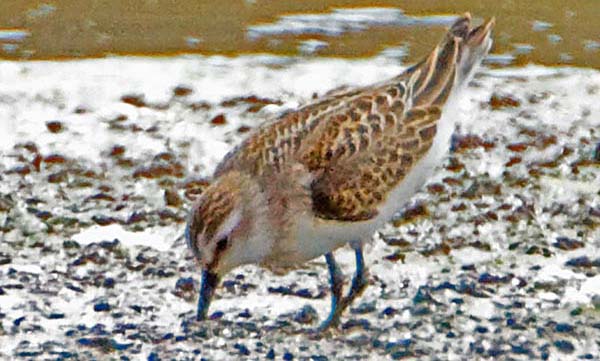 |
||||
We also spent a lot of time trying to determine primary projection and the relative length of the wingtip and tail tip. In the field both Todd and I felt that there were 3 primary tips showing beyond the longest tertial; perhaps you can get a feeling for this in Todd's photo (below left). I felt that in some views the tail was just barely longer than the longest primary, and that impression is supported by this shot, but in other views they seemed about equal in length. In my shot (below right), though, it looks like the central tail feathers are longer and pointed, and do extend beyond the wing tip. My shot (below right) also shows what was our field impression: the scapulars and greater coverts were all dark-centered, and so were the median and lesser coverts, so much so that the latter coalesced at the bend of the wing as a blackish blotch. Compare this washed out photo, though, to Bill Hill's shots on this page (e.g., just above) — Bill's photos show much better the actual colors of the fringes of all these feathers. |
||||
|
||||
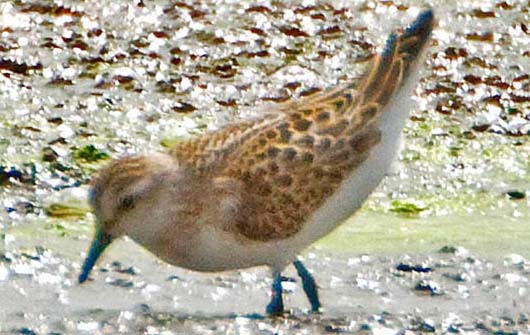 |
||||
The tertials looked quite dark to me, and rusty-fringed at their sides. Alström & Olsson (1989) consider this a diagnostic difference between Little (dark-centered tertials) and Rufous-necked Stint (paler gray-centered tertials). This feature shows well on a Bill Hill photo (just above). But on that same Bill Hill shot, some of the lower scaps and lower greater coverts appear to show an anchor-shaped subterminal pattern on a grayer center, much more like one would expect in Rufous-necked Stint. Alström & Olsson (1989) state that some Rufous-necked have dark-centered scaps, like Little, but they do not state either way whether Little Stint can sometimes have anchor-patterned scaps. So that is a mystery to me. In checking other literature later, I found a similar pattern to the lower greater coverts, at least, on a juvenal Little Stint photographed in Sweden (Paulson 1993; p. 258). Except for those problematic scaps, which I did not note in the field and only see on photos, the features we did see appear to favor Little over Rufous-necked Stint: otherwise dark-centered coverts/scaps; blackish-centered tertials; decided areas of streaking on sides of breast; white 'braces' (sometimes obvious); heavily streaked crown; and the split supercilium. |
||||
There is one prior record of juvenal Little Stint in Monterey County, and it was also on Pond #1 of Moonglow Dairy from 10-21 Sep 1985; see separate page with photos of that bird. California's first Little Stint was also in juvenal plumage, at Bolinas, Marin Co., 14-22 Sep 1983. Another juvenal was at Bolinas 22 Sep-14 Oct 1994. There are 3 records of adults in breeding plumage (one in May, two in July-Aug), and one in formative [=first-basic of Grant & Jønsson 1984] plumage was collected on Harper Dry Lake, San Bernardino Co., on 21 Nov 1988. It may have been attempting to winter there. The one prior record of Rufous-necked Stint was an adult in the Moss Landing Wildlife Area salt ponds from 13-14 July 2001 (color photo in Roberson 2002). There are 8 other California records of breeding (alternate) plumaged adults elsewhere in California's coastal counties. |
||||
Photos: All photos © Don Roberson, Todd Easterla, and Bill Hill, and used with permission, all rights reserved. Literature cited:
* note the British spelling of "juvenile;" like their English spelling of "grey" and "colour," is different than the American spelling devised by Humphrey & Parkes (1959), which first defined juvenal plumage. I use the American spelling here. |
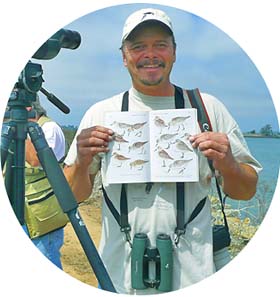 In
late morning 14 Sep 2008, Todd Easterla (right) discovered an interesting
juvenal-plumaged stint at Moonglow Dairy (above; center bird; the rest are Western Sandpiper C. mauri).
Rita Carratello and I went to look for it, as to a variety of other
locals (e.g., Bill Hill, Rick Fournier, Steve Rovell), while Kent Van
Vuren and Robert Horn just happened to be birding there separately, and
joined us. Soon there was a crowd studying this bird (below © T.
Easterla).
In
late morning 14 Sep 2008, Todd Easterla (right) discovered an interesting
juvenal-plumaged stint at Moonglow Dairy (above; center bird; the rest are Western Sandpiper C. mauri).
Rita Carratello and I went to look for it, as to a variety of other
locals (e.g., Bill Hill, Rick Fournier, Steve Rovell), while Kent Van
Vuren and Robert Horn just happened to be birding there separately, and
joined us. Soon there was a crowd studying this bird (below © T.
Easterla).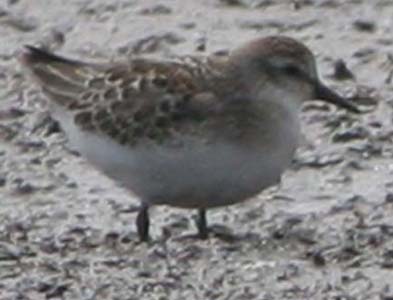
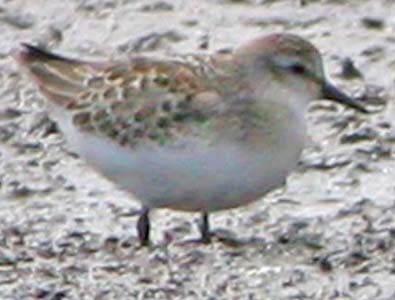
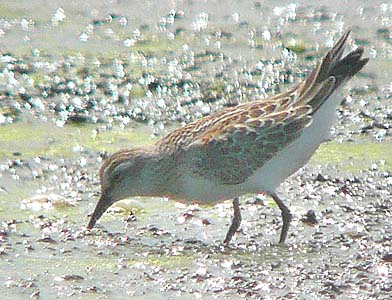

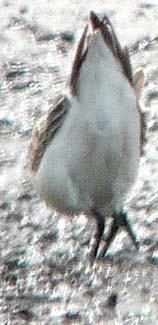
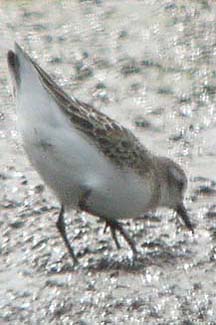

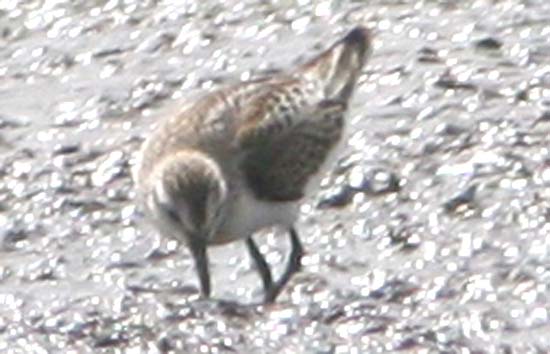 A
very striking character on this bird was a 'split supercilium,' a bit
more obvious on the left side than the right, but pretty obvious on
both, and it set off the dark ridge of the crown. The crown itself was
streaked and the thin fringes of feathers were reddish. The facial
pattern was set off by a dull grayish nape. Another fairly obvious
feature was a set of streaks on the sides of the breast. At best there
was a very faint wash of some warm color across the breast, but the
decided streaking was concentrated at the sides of the breast.
A
very striking character on this bird was a 'split supercilium,' a bit
more obvious on the left side than the right, but pretty obvious on
both, and it set off the dark ridge of the crown. The crown itself was
streaked and the thin fringes of feathers were reddish. The facial
pattern was set off by a dull grayish nape. Another fairly obvious
feature was a set of streaks on the sides of the breast. At best there
was a very faint wash of some warm color across the breast, but the
decided streaking was concentrated at the sides of the breast.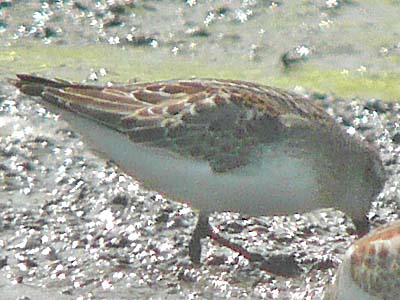
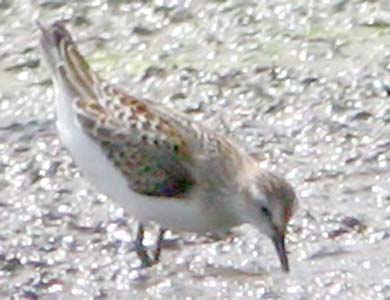
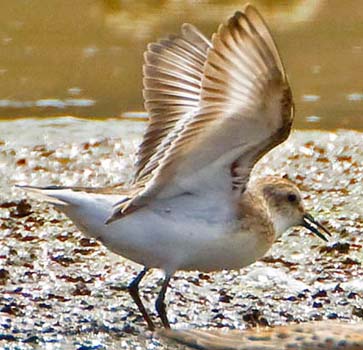 Unfortunately,
the tide was running out and mudflats began to appear on adjacent
Elkhorn Slough itself by mid-afternoon. About 2 p.m. the stint took
wing [Bill Hill shot, left] and flew up-slough with a large set of
Westerns. This was just as John Sorensen, Brian Weed, and others were
arrived. It did not return on 14 Sep, and was not refound on subsequent
days.
Unfortunately,
the tide was running out and mudflats began to appear on adjacent
Elkhorn Slough itself by mid-afternoon. About 2 p.m. the stint took
wing [Bill Hill shot, left] and flew up-slough with a large set of
Westerns. This was just as John Sorensen, Brian Weed, and others were
arrived. It did not return on 14 Sep, and was not refound on subsequent
days.